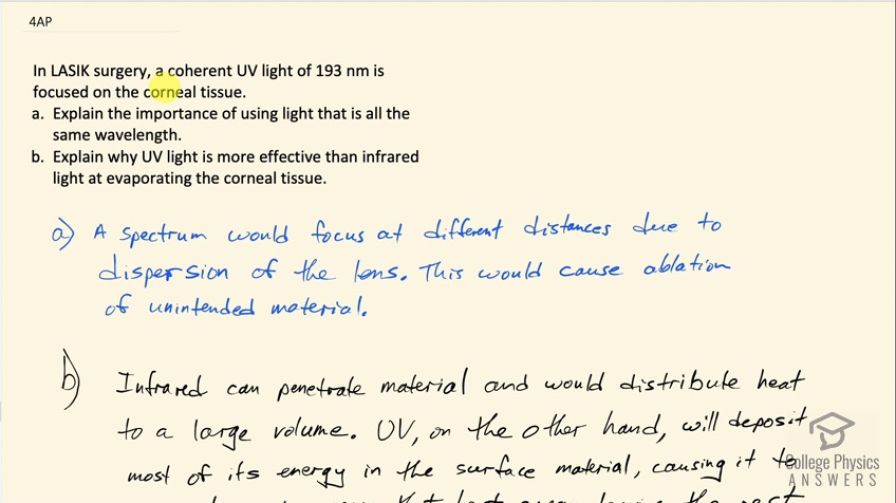Question
In LASIK surgery, a coherent UV light of 193 nm is focused on the corneal tissue.
- Explain the importance of using light that is all the same wavelength.
- Explain why UV light is more effective than infrared light at evaporating the corneal tissue.
Final Answer
- A spectrum of light would focus at a spectrum of distances due to dispersion of the lens. This would ablate a swath of material at a range of depths rather than corneal material at only one specific depth.
- Infrared can penetrate material and would distribute heat to a large volume. Ultraviolet, on the other hand, will deposit most of its energy in the surface material since UV can not penetrate. This will cause the surface material to reach such a high temperature that it will evaporate, which serves the dual purpose of the intended reshaping of the cornea, as well as transporting the heat away from the corneal tissue underneath that shouldn't be harmed.
Solution video
OpenStax College Physics for AP® Courses, Chapter 26, Problem 4 (Test Prep for AP® Courses)

vote with a rating of
votes with an average rating of
.
Video Transcript
This is College Physics Answers with Shaun Dychko. In LASIK surgery, ultraviolet light with wavelength of 193 nanometers is focused on corneal tissue to basically carve it and the question (a) is asking why is it important to use a light of a single wavelength? Well if there were a variety of wavelengths a spectrum in other words then the lens in the device that's focusing this ultraviolet light that lens will have a different index of refraction for each wavelength and that's called dispersion and it can be only a slight difference but when you are talking about you know precise measurements in eye surgery any difference could be a problem. So you know you will have this lens in your ultraviolet light and you'll have one color focusing at this position and then the next color focusing closer and you will have these two different spots getting focused on in the cornea that's being operated on and you will be basically carving away two different spots at the same time and that's not what's intended what's intended is to have only one spot being ablated— this word 'ablation' is the word for like basically making the material evaporate. Okay! So dispersion is bad and that's a problem when you have a spectrum of incident wavelengths. Okay! So the next question in part (b) is asking why is it more effective to use ultraviolet light instead of infrared? Well infrared light being a longer wavelength, it's able to penetrate material and so it would sink to some depth in the cornea and that means not all the waves would do that though some of the waves or photons would deposit at the surface of the cornea and other ones will penetrate deeper and you will have this distribution of the heat of these infrared rays throughout the volume of the cornea and that isn't good because you are going to be depositing heat in material that you don't want to affect whereas ultraviolet on the other hand does not penetrate the material and all of its energy will be deposited on the surface of the cornea and because of that all of its heat will be at the surface and then that will heat up a lot and then the material will evaporate and while evaporating, it's going to carry that heat away leaving the other cornea material, that's underneath it, unaffected.